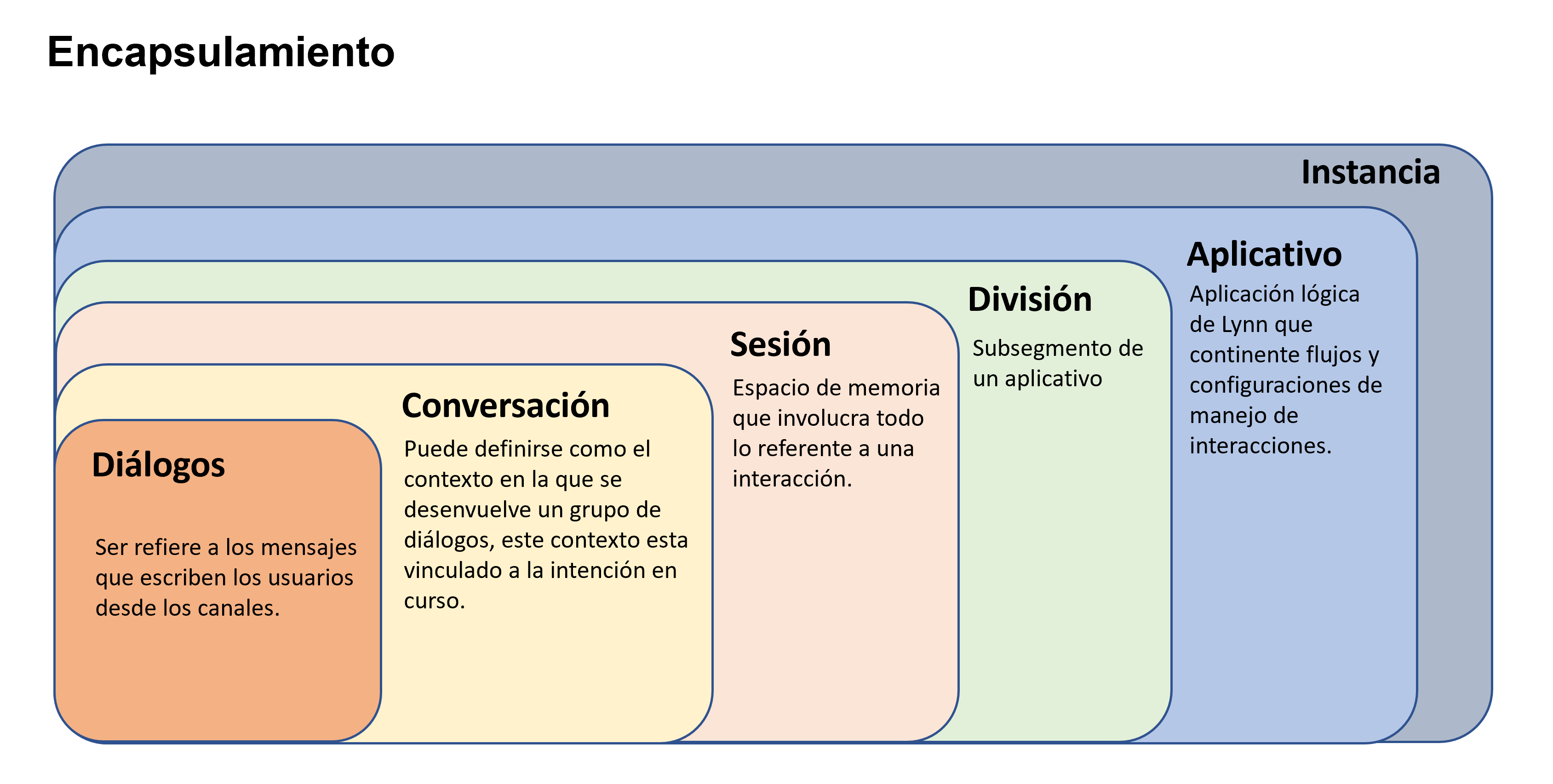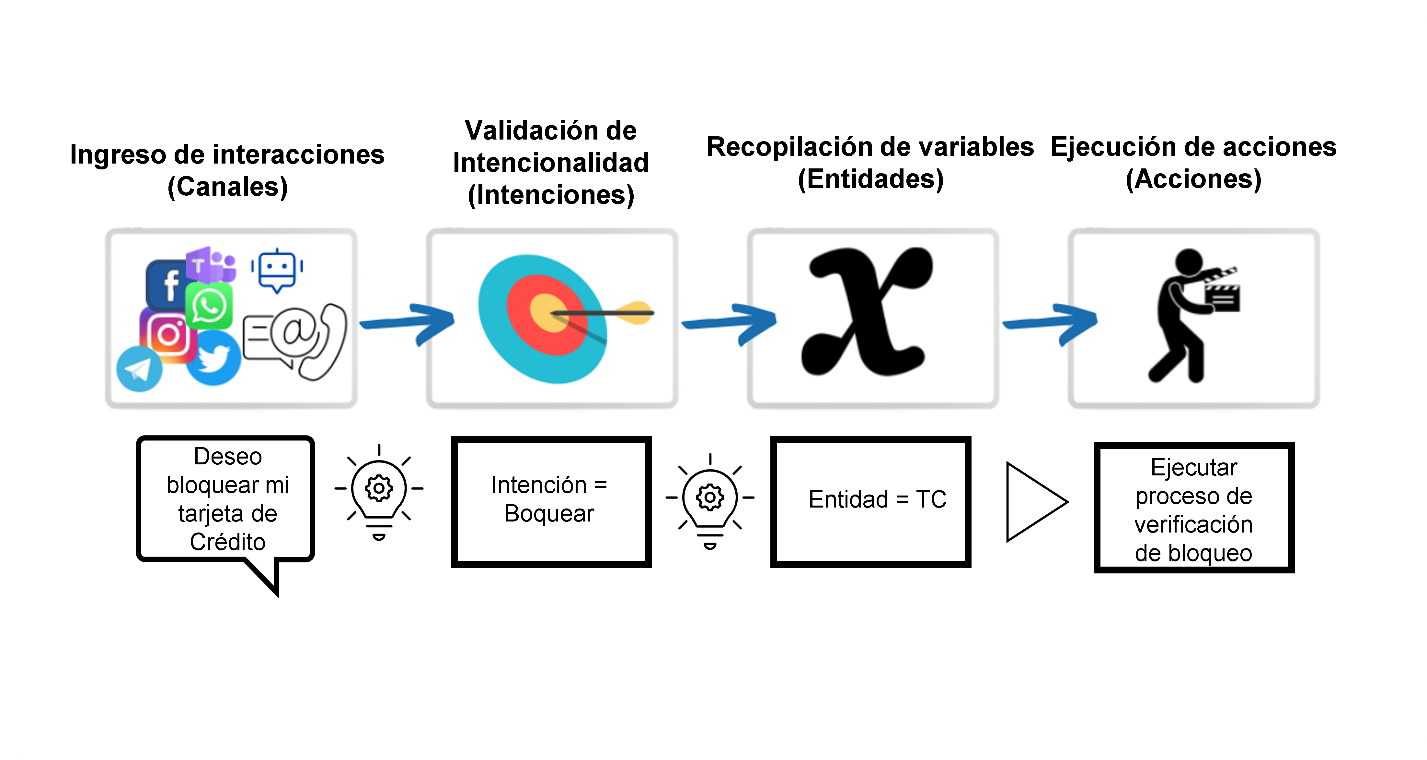Operating Logic
Lynn's operation is based on messaging integration and management. For this purpose, Lynn follows a logical separation model for applications. It involves the development of a logical design scheme and service aggregation, all centered around a visual administration interface. All of this is supported by a cloud platform.
Encapsulation structure
Lynn's logical model is based on an encapsulation structure:
Instance: group of resources dedicated to the operation of a set of applications, the instances are managed according to the region, density of sessions and characteristics of the applications that cohabit in them.
Application: is the logical representation of a business, within it is develop all the structures of design, connection, reports and management of interactions associated with a business. Each application is identified by a unique numbering known byTenantID.
Session: represents a memory space that contains all the information of an interaction being managed, sessions have a finite time which can be adjusted within the parameters of the channel in use, the sessions can be managed and their unique identifier is a relevant parameter for the tracking an interaction on the platformSessionID.
Conversations and Dialogues:Conversations are groupings that contain the context of the dialogues that are exchanged in Lynn, being possible distinguish conversations managed by bot or agent.

There are two types of conversations:
-Bot Conversations
-The participants in a bot conversation are thecustomerand the botconfigured for that tenant. The bot name matches the name of the tenant and that is how it is displayed in the graphical interfaces.
-Chat Conversations
-The participants in a conversation can theoretically be infinite, where the customer must always exist as the initiator of the conversation and on the other hand are the set of chat agents that can be connect to the conversation If an agent transfers the interaction to another agent, then that participant changes.
Important note:Dialogues processed in Lynn will be counted as effective if any of their source channels report them blank, the reason being that they are managed as valid in occupied resources for their manipulation, this is especially susceptible in cases of third-party integrations and messaging APIs.
Action: are a set of programmable elements that a flow designer can be used within the framework of a Tenant to define the flow of desired self-care. There are various types of actions, from the most basic that allow you to create a Dialog to send a text message to the user or advanced plugins that require multiple parameters for their correct operation. One of the most popular actions on the platform is heCode Bockthat allows to create programming codes in language JavaScript that are executed by Lynn within the framework of a session.
Intention:An intent is the executable element of a tenant's flow. representing the contextual purpose of a sentence or dialogue expressed by the customer. The intention is the result of submitting a sentence spoken or written by the client, to a process of interpretation by techniques for processing natural language through a cognitive engine. The result of this process is a response that contains the Intent and the % Confidentiality that the engine Cognitive gives you your answer. These cognitive engines require to be previously trained so that they have the ability to identify the Intention of a sentence spoken by a client, this training process is set up and runs through Lynn.
For more information on intention configuration, click Here
Entity: The entity is a variable that can be deduced from a sentence or dialogue indicated by a client after submitting it to a process of natural language interpretation. For example, from the following sentence:
My identity card is 1234567-8.
An entity called identity card with value can be deduced: 1234567-8. There are system entities that are inferred by default by engines cognitive, for example numbers, proper names, dates. Other entities must be trained in order to promote their recognition by the engine cognitive.
For more information on entity configuration, click Here
Attention channel:In Lynn, a service channel is the representation of the integration with a messaging program or social network from an external provider. Examples of service channels are: Whatsapp, Twitter, Facebook etc. exist customer service channels that have multiple customer integration implementations multiple providers.
Logical and aggregation modeling
The logical model is developed in Lynn according to flows that are structured according to the Intention-Entity model, which is compatible with the main exponents of cognitive services, so that the designs in Lynn are able to trigger actions from intentions and entities retrieved from the messages that are handled. It is not mandatory to have a cognitive service to structure a stream in Lynn, streams that lack cognitive services will simply behave linearly.
Channel: Means of data entry or interactions to Lynn, with the ability to manage sessions.
Intention: element with cognitive capacities of the intention-entity model that represents a use case or branch of work in Lynn. In a classic model would represent simile to the verb of a sentence.
Entity: element with cognitive capacities of the intention-entity model that represents a variable or definition about an intent. in a model classical would represent simile to part of the predicate of a sentence.
Case: Auxiliary logic element that assumes the function of connector between intentions and actions giving the possibility of defining execution order, execution logics and other resources that depend on the relationship intention-entity. It is also identified as subroutine points.

All the elements that make up the encapsulation and the aggregation logic of the intent and entity model ( Channels, intents, entities, actions ) are considered logical elements in Lynn.